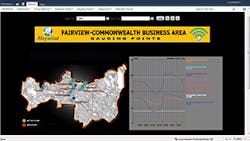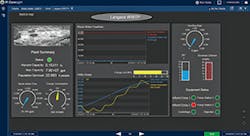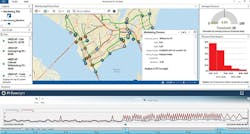Accomplish More With Less
Rising power prices, new environmental regulations, and budget constraints are prompting many utilities—and large industrial users of water—to start looking at the Internet of Things (IoT). By fine-tuning existing processes or leveraging predictive analytics, large water consumers are finding ways to reduce their costs and carbon footprints without major retrofits or new hardware investments. While water utilities and large water consumers have employed SCADA systems and automation for years to control their operations, this shift to digital analytics will mark a fundamental turning point in the industry. Water utilities will literally be able to accomplish more with less.
THE ENERGY AND WATER NEXUS
The first and most obvious way IoT can help is through reducing energy usage. Typically, energy accounts for 30% of a utility’s operational expenses, an amount second only to personnel. Often, water utilities are the largest or second largest consumers of energy in their regions. The energy consumed annually in treating and distributing water and wastewater in the US accounts for around 3% of national energy consumption.
Energy savings come about in indirect and surprising ways. Some techniques of reducing power purchased from the grid—reducing the number of active assets at a site, repairing failing equipment or harvesting biogas for internal operations, etc.—are fairly straightforward.
As an example, Thames Water, the water utility for London that serves over 15 million customers, uses the equivalent of 2% of all of the electricity in the UK. The Asset and Operations Real Time Analytics (AORTA) initiative at Thames Water is part of an overall effort to optimize the efficiency and energy performance of its water and wastewater infrastructure. Over a five year period, the utility anticipates it will save multiple millions in Euros.
In Boston, the Massachusetts Water Resources Authority (MWRA) leverages their real-time information and infrastructure, the PI System, to reduce energy costs by $14 million a year.
They employ time-of-use electricity rates and work closely with the ISO New England power utility to reduce demand and costs through time-of-use and other incentives. MWRA also supplements power by burning digester gas through their cogeneration engines.
THE LOST WATER PROBLEM
But what about leakage control? In many cities, 30% or more of the potable water prepared by a utility never makes it to customers, thanks to leaks in pipes. Imagine if your company lost 30% of their product on the way to market.
A dashboard from Maynilad
Maynilad, the privatized water authority for Manila, serves millions of customers over 540 square kilometers: it manages nearly 7,500 kilometers of water and sewer pipes and 19 reservoirs. In 2007, nearly 80% of the citizens in its service area were connected to the water system but only had intermittent access to water, while about 20% couldn’t get water at all.
As part of an operational overhaul, the company pursued an aggressive program to monitor metrics like water flows while mapping consumption against its geographies. By 2013, it was servicing 94.7% percent of its customers, 97% had 24-hour service, and 99% had sufficient pressure. At the same time, Maynilad recovered 640 million liters of treated water, thereby reducing losses by 27%, while increasing its customer base from 6.4 million to 9 million.
Halifax Water in Canada, meanwhile, manages water and wastewater for about 325,000 residents. The water distribution network consists of 1,300 kilometers of pipe and they manage water loss in real time, which saves 38 million liters of water per day in real losses. Through aggressive data management, Halifax Water has reduced leakage of potable water, a direct savings of almost $600,000 per year. This is equivalent to saving almost $2 per person served each year.
FIX IT
Evides, the second largest water company in the Netherlands, manages industrial water, wastewater, and drinking water for 2.5 million people. The GAMEs playground (Geographical Asset Management at Evides) was created to leverage best-of-breed technologies to address key business issues including leakage, flood depths, risk, and metering. In 2016, a large 630-millimeter pipe burst in Vlaardingen. Pressure dropped from 30 meters to 6 meters while flow increased from 700 cubic meters per hour to approximately 4,300 cubic meters per hour. GAMEs let Evides pinpoint the individual pipe that burst and serve up information on which valves needed to be closed to isolate flooding. GAMEs also allows Evides to send messages
to customers in the affected area to warn them of the problem. Operations returned to normal in around two hours.
Another Dutch water company, Vitens, has created a Vitens Innovation Playground (VIP) that uses the same online data management software technology to detect a leak within two minutes through sensor data.
BIG INDUSTRY GETS INVOLVED
IBM employed analysis of real-time operational data and environmental data like local weather and dew point to reduce water consumption in its semiconductor fabrication facility in Burlington, VT, by 27% at a time when it also increased the overall capacity of the facility by 30%. While reducing water cut expenses, it also enabled the company to curtail natural gas costs. Water purification is one of the primary drivers of energy consumption in a fabrication facility. Combined, water and gas reductions save IBM Burlington approximately $10 million a year. (The facility is now owned by Global Crossing.)
Similarly, the Seattle Mariners, a major league baseball team, cut consumption by 10% over 3 years, or 2 million gallons, through “hard” upgrades like low-flow toilets and softer improvements like better data monitoring.
“There was a month in the off-season when we saw a large spike in water use that didn’t make sense,” Joe Myhra, groundsman for the Mariners, told the Guardian UK. “We were able to look at data and realize we had a leak in one of the fire hydrant lines. The leak wouldn’t [otherwise] have been visible until it was too late.”
CONCLUSIONS
It is evident that energy and water are interdependent and their uses are bound to each other. In order to increase efficiencies and to reduce the consumption and demand for both water and energy, information is needed. Decision-makers rely on easily accessible, accurate, real-time, and historical data to make the best informed decisions while remaining sustainable.



